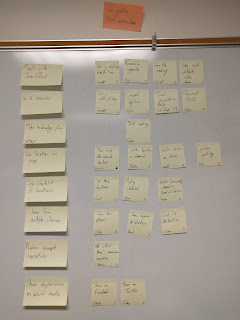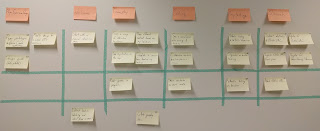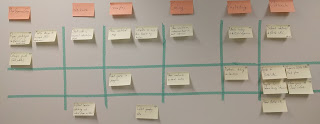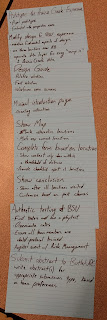I realized long ago that part of the problem was this word, "essay," which is used by different people for vastly different purposes. I found myself writing the same response to each student, and so I put together the following stock instructions. These have appeared on many course descriptions under the heading, "An etymological note."
Some assignments and achievements require the writing of an “essay.” I use this term in the classical sense, to describe a composition that represents an attempt to understand a complex idea. An essay is neither a summary nor a staid five-paragraph construction. As the course prerequisite implies, these essays should represent collegiate-level writing. You are encouraged to leverage our digital writing environment to compose multimodal pieces.For the record, I believe I have had zero multimodal compositions submitted in response to essay prompts—not so much as a photograph or illustration. I like to keep this door open, though, since students are required to take a college composition course before CS222, a course which explores more than just traditional prose.
After putting this note into the course descriptions, it has made it a bit easier for me give feedback: instead of writing out belabored instructions about what I mean when I say "essay," I can just point back to the course description. Even in this case, however, revisions don't always show that students have read and understood these instructions. The instances that come to mind tend to be structural problems, where the first submission lacks paragraph structure, and the second submission does too. It's enough to make me wonder if the real problem is ignorance about fundamental structuring tools, but usually, eventually, we get to a point where a revision is acceptable, though never elegant. I always recommend the use of BSU's Writing Center, but I have no idea if my students are using it or not. (Turns out, writing this blog post pushed me to reach out to them, and they do collect some self-reported data from visitors; they're going to try to let me know what kind of visits they've had from CS222 over the past few years. Neat!)
This semester, after frustration and reflection about last semester's writing, I decided to change my instructions on the course description. It was during the winter break that I took some time to compose a piece about what it means to compose an essay. I suppose I went full-meta. Here's what appears on this semester's CS222 course description, under the new and simpler heading, "Essays":
Some assignments and achievements require the writing of an “essay.” I use this term in the classical sense, to describe a composition that represents an attempt to understand a complex idea. An essay needs to have a point—a theme, a thesis, a central question. This should be supported by evidence, with assumptions identified and claims justified or cited. As implied by this course's prerequisites, our essays should represent college-level writing.
An essay, properly written, should hurt a bit. If you are truly writing to understand, then you have to be challenging yourself. If you are only summarizing something you have read or previously believed, it is not an “essay” by our definition.
Writing in this way has implications for structure and form. One long rambling paragraph cannot be an essay: each paragraph should have a clear and coherent theme that supports the central argument, and you need more than one of these to support an argument worth forwarding. The fact that we are writing in a digital environment should not be overlooked: you can include images, video, sound, and hyperlinks, following the same judgement you would use to include any formal element. Even typefaces, colors, and margins are part of a digital composition. These have meaning, and because of that, you should not change them unless you are proficient in digital document design: the defaults are provided because of their generality, and they are likely appropriate for your compositions.
The Elements of Style provides an excellent refresher on how to produce good, clear writing. It is a short, affordable book in its latest release, and the earliest printings are in the public domain (see archive.org, for example).I'll point out a few pain points that were on my mind when I wrote this. First, a great many of the submissions don't have a point: no thesis, no theme, no conclusion. I wanted to get at that right from the beginning, because if they do nothing else, I would like them to at least have a point.
The second paragraph is about pain. I see a lot of students write in generalities, avoiding specifics, avoiding culpability, avoiding conclusions. I believe that learning should hurt a little, because it's forcing you to confront something you misunderstand. This may be a lofty goal for a 200-level course, but I wanted to see what happened if I put it out there. Looking at it now, maybe I should revise that paragraph to be more about discussing concrete details rather than throwing around abstractions and generalities.
The third paragraph reflects my continual bafflement at how bad students are at using modern writing technology. We're using Google Docs, so we're not just digital, we're connected. Yet, students practically never include the URLs to their sources, much less actual hyperlinks. What many students do, that I react to in the paragraph, is fart around with fonts and sizes, almost always in ways that distract from the readability of the document. I know that the prerequisite writing course covers a bit of visual design, but clearly, students are not coming through with the self-awareness that they are bad at it. That's understandable coming out of a freshman-level course (isn't that what being a "sophomore" is all about, after all?), but what bothers me is that it's not clear that they understood that these choices have meaning. That is, the choices I see appear arbitrary, not treated like the design decisions that they are.
The last paragraph is my way of sharing my excitement at finding out The Elements of Style first edition was in the public domain. I was required to buy a copy of this book (not the first edition, naturally) in my first semester of grad school, as part of a research seminar course in which faculty presented their research and new grad students wrote essay responses. I remember enjoying the book, not so much because of the structural concepts—I've always been a decent writer, after all—but because it helped me collect my reasons for good writing practice. Maybe it's too much to expect that a sophomore CS major would go fall in love with style, but a guy can dream.
That's the story behind my revised essay-on-essays. I see some parts that I will likely clean up between semesters. So far, it's not clear that it's made any difference at all, except again for the time it saves me: I have referred a handful of students to it after they turn in something completely unstructured or inappropriate.





